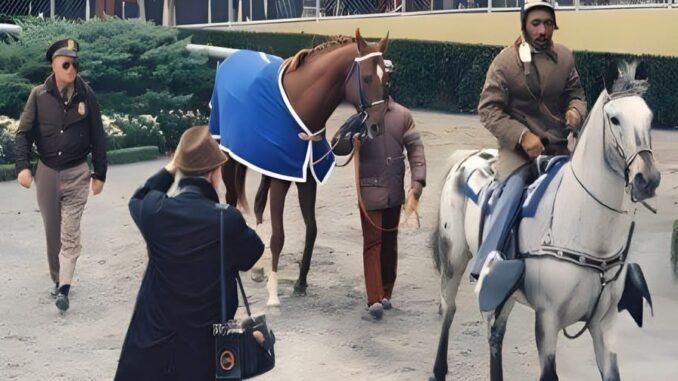
The Forgotten Warrior: Sham’s Heroic Struggle in the Shadow of Secretariat’s Belmont Glory
In the pantheon of American horse racing, Secretariat’s 1973 Belmont Stakes triumph is often hailed as the single greatest performance in the sport’s history — a thunderous, 31-length demolition that shattered records and ignited imaginations. Yet behind that legendary win lies a quieter, more somber story — one of courage, grit, and heartbreak. It’s the story of Sham, the magnificent colt who chased greatness until his body gave out, quite literally, under the weight of history.
Though remembered now as Secretariat’s gallant rival, Sham was no mere footnote. He was a racehorse of exceptional talent, a powerful bay with a huge, determined heart — both figuratively and literally. In another era, Sham may have been a Triple Crown winner himself. But fate placed him in the same starting gates as Big Red, and that twist of timing would define his legacy in both triumph and tragedy.
The Rivalry That Defined an Era
Leading up to the 1973 Belmont Stakes, Sham had already proven himself a formidable challenger. Trained by the savvy Frank “Pancho” Martin and ridden by jockey Laffit Pincay Jr., Sham finished second to Secretariat in both the Kentucky Derby and the Preakness Stakes. In fact, during the Derby, he clocked the second-fastest time in the race’s history — faster than any other Derby winner except Secretariat.
Sham was no slouch. He was a powerhouse, lean and muscular, with an 18-pound heart — significantly larger than average, although smaller than Secretariat’s now-famous 22-pound cardiac engine. The two were mirror images in many ways: both bold, both fast, both relentless.
By the time the Belmont arrived, the racing world buzzed with anticipation. Could Sham finally turn the tables? Would Secretariat falter over the grueling mile-and-a-half distance? Few predicted the carnage that was about to unfold — not among the horses, and certainly not in the hearts of those watching.
A Brutal Start: The Toll of an Unsustainable Pace
From the moment the gates flew open at Belmont Park, the two titans charged out like cannonballs. They matched each other stride for stride through the first six furlongs, blazing ahead at a blistering pace. The opening half-mile was run in just 46⅖ seconds — suicidal by Belmont standards. It was a duel that took no prisoners.
By the three-quarter-mile mark, Sham began to fade. His head bobbed, his stride shortened, and his hooves pounded heavier with each step. Secretariat, meanwhile, found another gear and surged forward into the history books, stretching the lead to an unfathomable 31 lengths as the crowd erupted in awe.
What few knew at the time was that Sham was running on a cracked cannon bone — a hairline fracture in his right front leg, likely caused by the strain of that relentless early pace. The injury was not immediately obvious. He crossed the finish line in last place, staggering, exhausted, his will outpacing his body.
Diagnosis and Retirement
In the days that followed, Sham’s team became concerned by his lameness. A veterinary exam confirmed the fracture, and Sham was pulled from competition. The injury, while not catastrophic, required surgical intervention. Three screws were inserted to stabilize the leg, and Sham was officially retired from racing. His record would remain an incomplete masterpiece — a career of promise cut short by the very race that defined another horse’s legend.
“It broke our hearts,” trainer Pancho Martin later said. “He gave everything that day. He went to war. And he paid the price.”
Despite the career-ending injury, Sham’s connections knew they had a horse of tremendous physical gifts. His large heart, remarkable stamina, and fearless tenacity earned him respect in breeding circles. Though he never sired a star to match his own talent, Sham’s lineage carried on quietly in the background of the sport.
Overshadowed, but Never Forgotten
The tragedy of Sham’s career is not that he failed — but that he flew too close to the sun. Were it not for Secretariat’s astronomical brilliance, Sham’s performances in the Triple Crown would have been historic. His second-place Derby time was better than any previous winner except for the one horse who beat him. In the Preakness, he fought tooth and nail down the stretch. And in the Belmont, he ran with a courage few could fathom, knowing his body was giving out stride by stride.
In hindsight, Sham’s legacy has grown deeper with the passing decades. He has come to represent something more than a competitor — he is the embodiment of noble effort, the warrior who faced impossible odds and gave everything anyway.
There is no statue for Sham. No commemorative plaque or race named in his honor. But those who truly know racing — who understand what it means to run beyond pain, beyond fear, beyond logic — remember Sham not as a runner-up, but as a hero in his own right.
A Legacy Etched in Pain and Pride
The Belmont Stakes of 1973 is etched in marble as Secretariat’s masterpiece. But look closely at the shadows trailing behind that 31-length miracle, and you’ll see Sham — brave, battered, and broken, yet still galloping with every ounce of heart.
Because sometimes, the greatest stories in sport aren’t about the winners. They’re about those who dared to chase them.
Leave a Reply